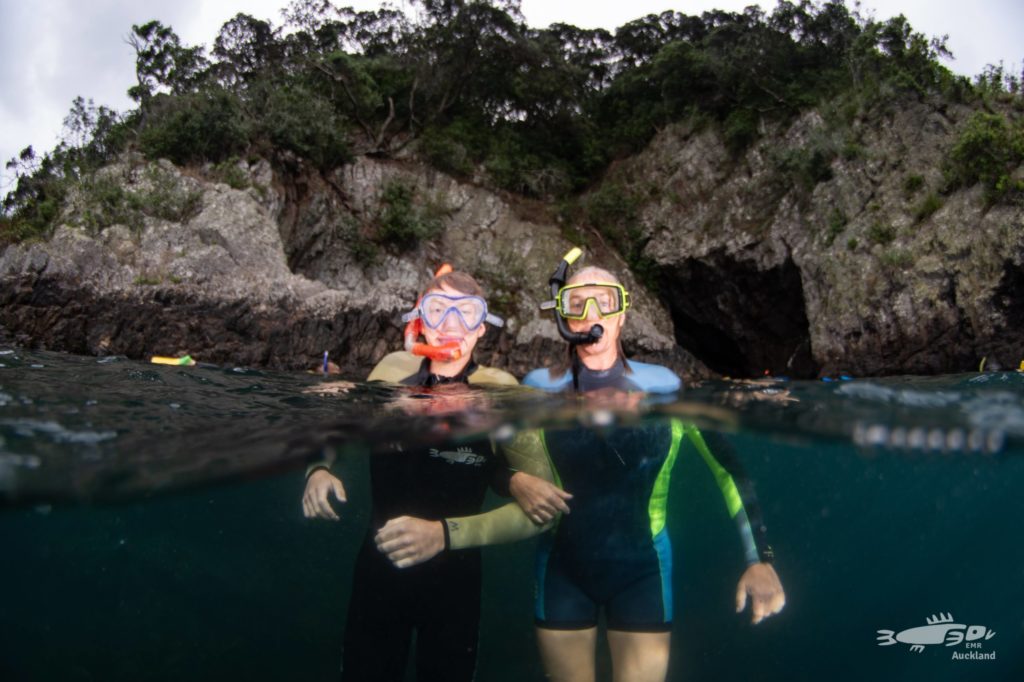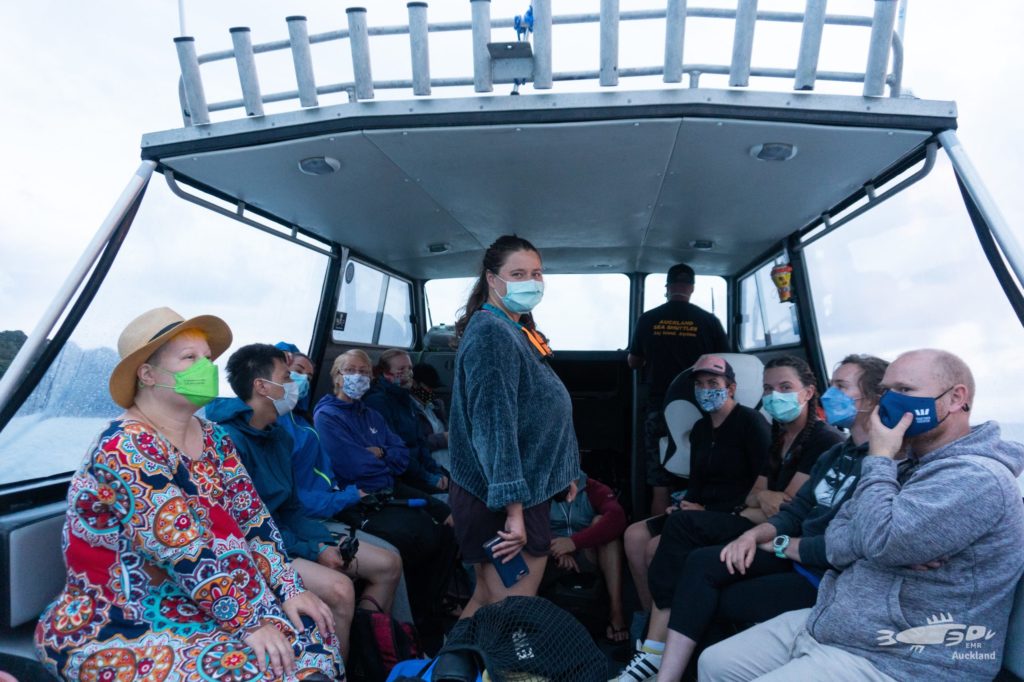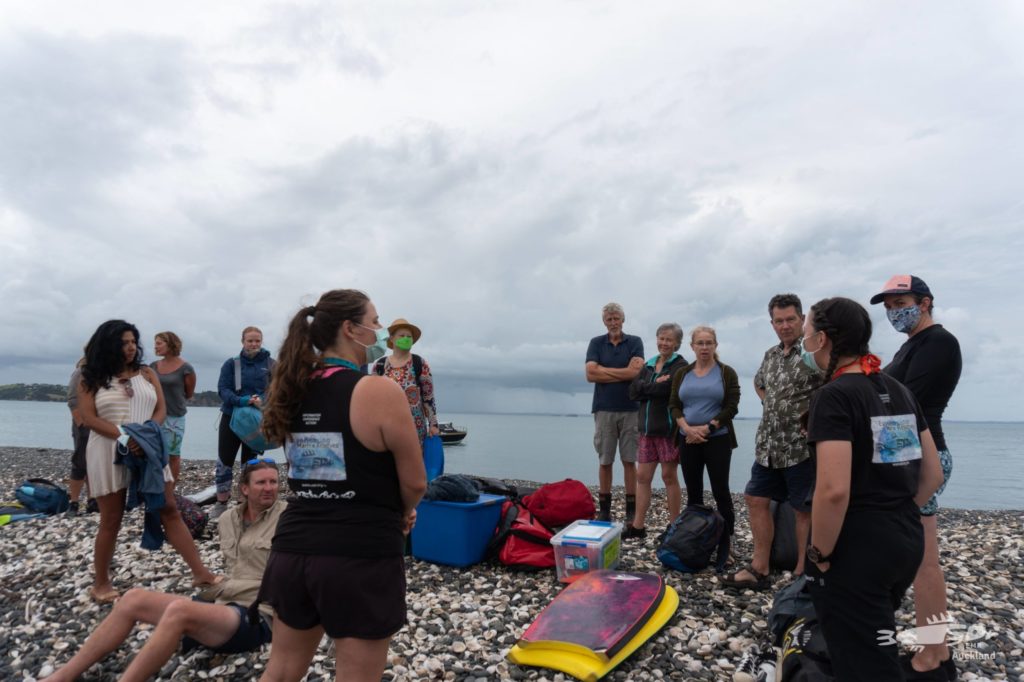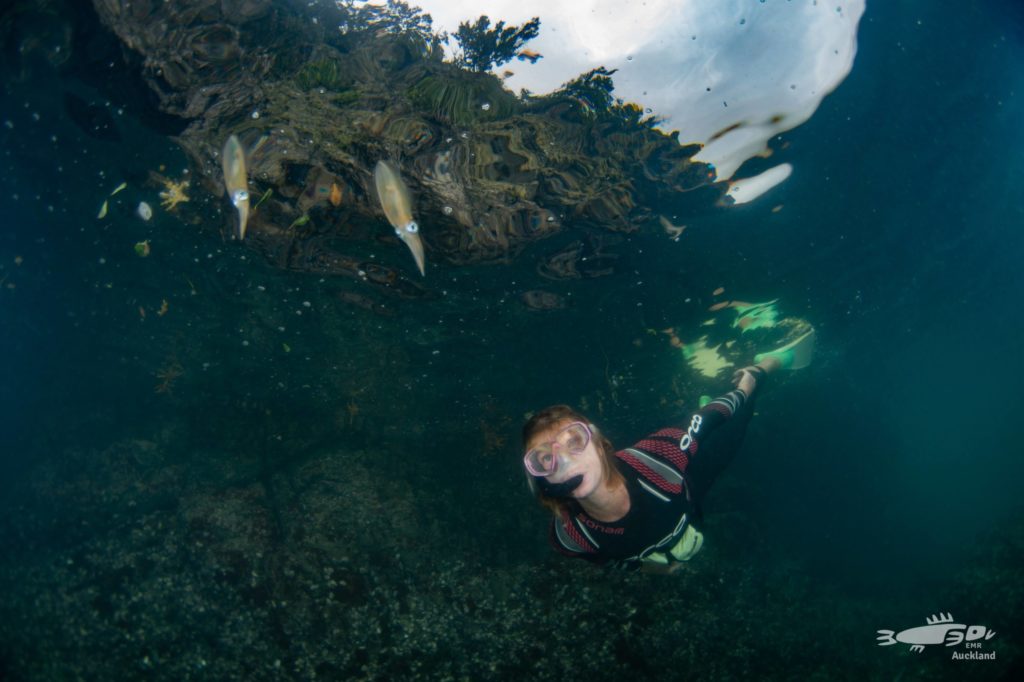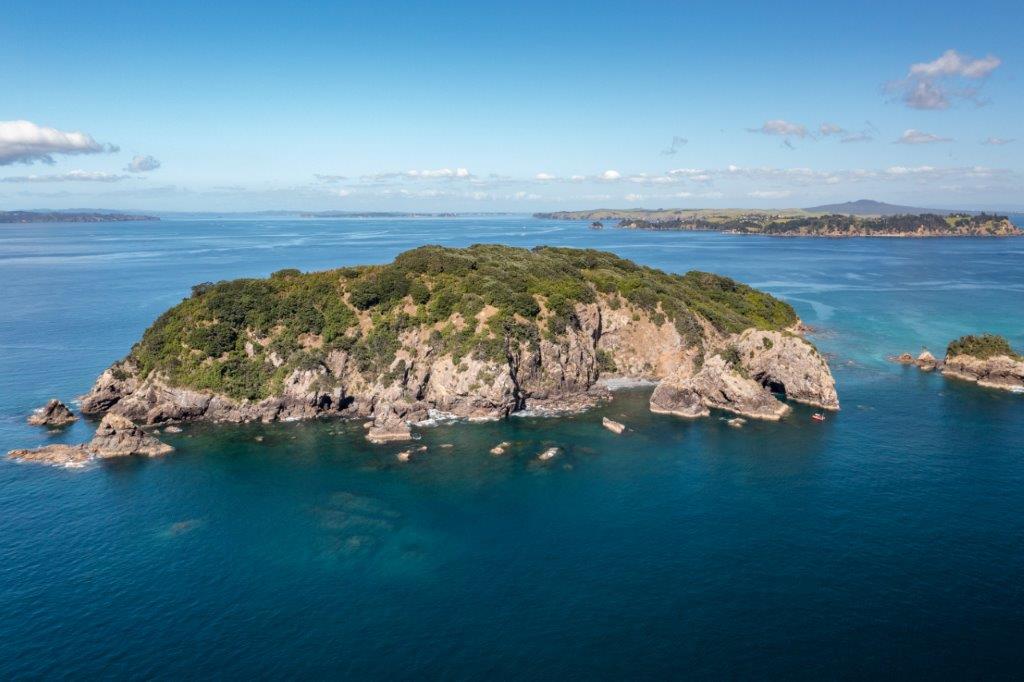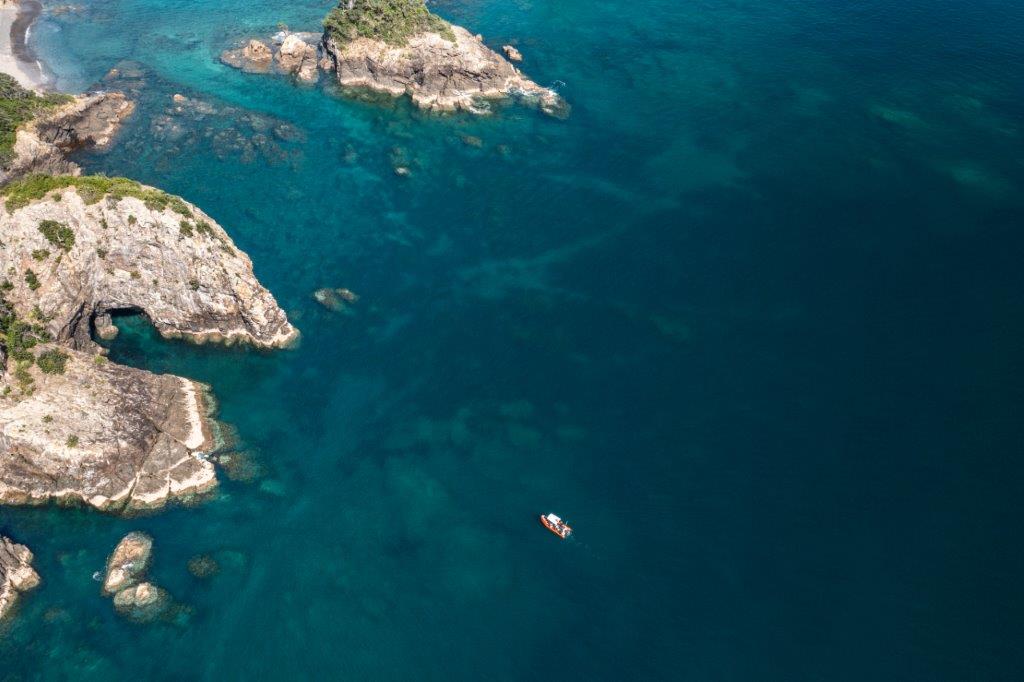The Noises hold a very special interest for seabird lovers. Being home to at least…
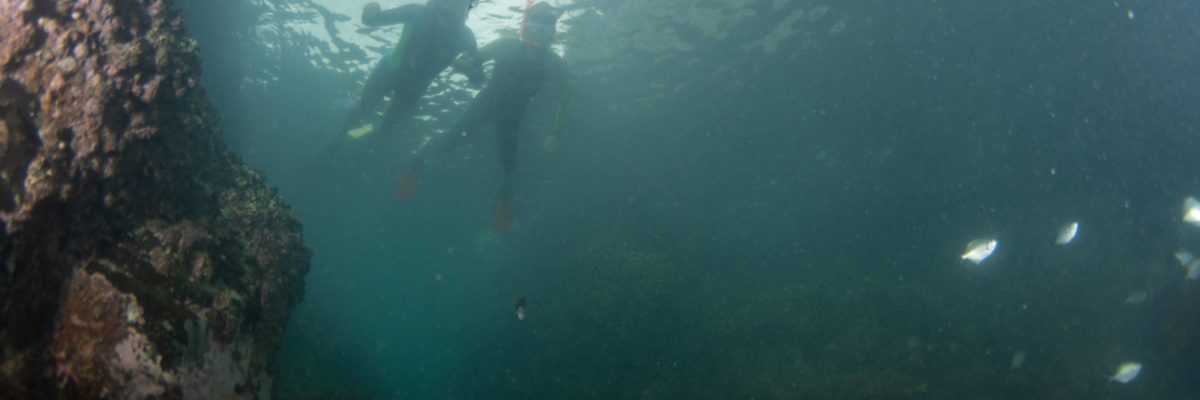
The neighbours that snorkel together
A splendid splashy tale about the day the neighbours came round for a snorkel.
When people think of the Neureuter’s neighbours on The Noises, they tend to think of seabirds. Of noisy petrels and species of shag, of gannets and gulls, not to mention tūi and piwakawaka. You might also think of wetapunga, geckos, or skinks. But, looking a little further afield, their other nearest neighbour is Rakino Island, a mere hop, skip and a paddle across the channel. Bearing in mind all the islands of the Hauraki Gulf are connected, it makes sense to get to know your neighbours, which is why Experiencing Marine Reserves (EMR) organised an event that saw 10 lucky Rakino-ites visit Ōtata for a snorkel.
But how did this expedition come to pass, you ask? Well, in March 2019, Dr Tim Haggitt conducted a benthic marine survey around the waters of Rakino Island. Made possible thanks to a grant from Foundation North, this was the first survey of its kind for Rakino, with the intention of collecting baseline data to add to the body of scientific information that had already being gathered across Tīkapa Moana / The Hauraki Gulf.
The survey itself didn’t uncover anything particularly surprising, and a lot of data reflected similar findings from the neighbouring Noises, but it was all grist for the conservation mill as several organisations work towards increased marine protection of these increasingly degraded waters. Because the local Rakino community was eager to hear what Tim had learned from the survey, an informative event was scheduled for January 2021. Dubbed Talks and Snorks, Tim intended to share his findings, then take the locals on a guided snorkel.
Unfortunately, America’s Cup racing was taking place that same day, which meant travel to and from Rakino was rendered impractical. Another date was set for March, only for that attempt to be scuppered by a short Covid lockdown.
Determined not to lose momentum, yet another date was set for January 15 2022, and, in spite of a potential cyclone and a tsunami warning, it was deemed safe to press on. Although there was one more spanner in the works in the form of an injury, with poor Tim suffering from a suspected broken cheek after a novice surfer careened into him up near Leigh a week prior.
In spite of the pain and a flamboyant bruise, Tim was insistent the show go on, even though he was unable to don a dive mask, so Lorna Doogan was asked to step in and guide the snorkel. As national coordinator of EMR – an organisation that is dedicated to helping people enjoy our unique ocean environments with a focus on education and conservation – Lorna proved the perfect substitute snorkel guide. Not only did Lorna agree to lead the snorkel, but she also suggested she turn the visit into an official EMR event.
Then there was the weather warning, and loads of locals decamping due to impending ferry cancellations, the talk was a great success. With a full house that included Rod and Sue Neureuter, the Rakino Hall was virtually busting at the seams.
A similarly large number enjoyed the guided snorkel at West Bay and, upon seeing the local people’s enthusiasm for the underwater world, and noting their curiosity for what was happening at The Noises, it was suggested some Rakino people might like to try snorkelling on Ōtata – and a seed was sown and a date was set.
Being able to see The Noises from many points on Rakino, interest was strong and on February 19, 10 Rakino Islanders signed up for the Ōtata snorkel odyssey.
No one was deterred by the prospect of poor visibility, or the early start. At 7am Skipper Steve from Auckland Sea Shuttles collected the keen snorkellers from the wharf and transported them across the channel. Once deposited on Ōtata, Sue welcomed them to the island and Lorna said a karakia before the small group introduced themselves and revealed what their favourite sea creature was.
Donning wetsuits, masks and snorkels, either BYO or borrowed from EMR, the aquatic adventurers were warned not to expect the best visibility following cyclones and a tsunami that rendered the water rather turbid but, in spite of marginal visibility, it was a most excellent snorkel.
Entering the water at Blinking Eye Bay the group headed east around the rocks, exploring the little crevices and crannies close to shore. Lorna took phenomenal photos both in and under the water while Sue and the EMR volunteers pointed various delights that might not have been noticed by the less experienced eye.
Species spotted ranged from easily recognisable tamure/snapper to juvenile jet-propelled wheke/squid. It wasn’t easy to spot them, but once you’d seen one – the eyes are the giveaway – your own eyes learn to recognise them more readily. Silver drummer, koheru, red moki, piper, spotties, wrasse and goatfish were all also spied.
Several snorkellers wondered why they didn’t see such a broad range of species on their own island. Was there more diversity around Ōtata? Or were people more attentive on an intentional guided snorkel? Was it the very nature of being guided – to have cool things pointed out by those with sharper eyes and greater knowledge?
When the chill finally drove the people back on to land, Sue kindly offered to take the manuhiri onto the island, past the fallen pohutukawa, and up to the clearing that looks across to Motuhorupapa, pointing out wetapunga and various other wonders along the way.
It’s fair to say neighbours of The Noises were enthralled, until all too soon it was time to clamber back aboard the sea shuttle and return to Rakino just in time for lunch.
Judging by the comments on the feedback forms, the trip was a huge success with every single participant declaring it a magnificent morning of exploration, education and enlightenment. Everybody expressed deep gratitude to the Neureuter family for welcoming them and to EMR for pulling it all together. The group was chuffed to have seen so many amazing things, in spite of the ho-hum conditions, and they also imagined how extraordinary the waters around Ōtata and The Noises would look if they were protected.
